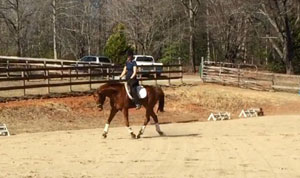Living down here in South Carolina, I know I am taking a big chance in being chased across my farm by northern riders, carrying whips, if I dare complain about the weather this winter. But it has been difficult. And just plain annoying. No, we are not buried under snow and ice, but it seems as though every dry day we are assailed with winds so high (it took me several minutes to find ‘B’ and ‘F’ blown into the woods) that it’s simply unfair to the horses, if not downright dangerous, to ride.
But then this past week we had a delicious run of sunny weather with highs in the mid 60s. And yes, sustained winds of 15 and 20mph accompanied it. But knowing this was as good as it was going to get, I donned shirt sleeves in February, tacked up Forrest and took him into the arena anxious to see if the magnesium supplement I have started him on would help him focus his spooky, wind-based behavior.
I have to say he was pretty darned good: we had one big spook at the beginning of the ride which was understandable as a limb in the woods came cracking down during a particularly big gust. But after that, as the following photos will attest, he was lovely, soft, calm and obedient.

What I have begun incorporating into our training is an excellent test for both horse and rider: riding, pretty much exclusively, quarter line in all three gaits. For the horse, it takes away the crutch of the rail to lean upon and for the rider, you learn in a hurry how to ride your horse straight and through, using both legs effectively and maintaining an honest connection.
Shoulder fore is the movement many a dressage horse lives in for the rest of its natural life. And realizing it’s the only true way to keep a horse really straight, after warming up with some bending lines and a few leg yields in walk and trot, both spiraling in and out of a 20-meter circle and from quarter line to the rail and back again, I pick up a nice, “forward-thinking” working trot with Forrest, and swing across the diagonal

and then through the short side, testing that he is yielding through his ribcage before turning down quarter line before the second corner and riding straight ahead in shoulder-fore positioning:

I don’t ask Forrest to remain in shoulder fore the entire long side quite yet, so we turn off at E and ride a short diagonal before looping around and mirroring what we’ve done off the other rein.
On days like this when, despite wearing sunglasses, my eyes are watering so badly I can barely see, I imagine it can’t be pleasant for my horse, either, especially considering the sand that’s blowing up, so to reward him for being such a trooper, we keep this session brief, ending with a nice stretch.

Certainly I would have liked to have worked longer but it is what it is: winter. We can’t control the weather but for those of us without covered arenas, what we can control is the quality of our work outs and the welfare of our horses.












